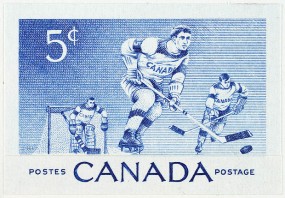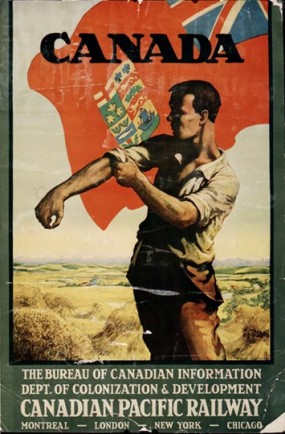Communities and Borders
- How are communities and other social structures that make up the shared space of a community or event represented? Are there suggested borders that dictate actions and perceptions, or form subcultures or communities? What features, figures, or actions are emphasized within these structures? What do these suggest about community values, autonomy and freedoms, and ideas of belonging?
- How does a diverse community relate internally between members, and externally to the rest of the world? How is this impacted by diasporic processes of emigration and immigration that construct relationships across the globe?
- How does a shared location or experience influence the perception and conceptualization of others (insider-outsider dynamics)? How are these borders of experience marked socially, spatially, culturally, and so forth?
-

Canadian stamp, issued 23 January 1956. Hockey has become a classic symbol of Canada’s rugged northernness. Canada Post Corporation and Library and Archives Canada. Accession Number 1989-040, e000756674
How are communities located regionally? Are there hints of the myth of Canada as North, rural, rugged, and resource-based, or is an urban perspective favoured (see Rudy Wiebe’s commentary
On Being Canadian
and Sherrill Grace’s book reviewTelling Our Stories
)? How do these emphases alter our perceptions of the story? - How do regional differences or suggestions of tension between one location and another offer an alternative perspective to nationalist unity? How do these tensions facilitate the development of the story? This may be expressed in a tension between notions of home and away, living and visiting, as well as between political and economic centres and peripheries.
Multiple Histories
- How do Canada’s multiple historical perspectives (colonial, Indigenous, or immigrant) influence our perceptions of the nation and its diverse communities? Who is included in the notion of our, and who might not want to be included at all? How are these histories represented or not? Are there purposeful gaps in the representation of these histories, traditions, or voices to suggest or represent holes in the national dialogue, to represent silenced voices and experiences?
- Consider how narratives engage with history. Does the work reinforce or interrogate common assumptions about a particular moment or myth? Does the work introduce alternative or silenced voices, acting as what Herb Wyile calls a
speculative
historical fiction? Discuss how this is represented in the work, and what questions the narrative or poem opens up regarding the construction of history. Consider especially concerns about power, knowledge, and identity. -

“Passeport de saison, Expo ’67. People at Expo could collect stamps from national pavilions in this passport. Library and Archives Canada, archive number R9534-1-1-F, e001096752
National moments, events, or periods, such as European contact and expansion, the War of 1812, the World Wars, and more currently, the war in Afghanistan, as well as other moments like the hosting of the Olympics and Expo, can be assigned specific communal value which supports or detracts from a sense of national loyalty and unity. How was this history made? Who made the decisions to go to war or to host a festival or event? How was this event publicized, promoted, and later publicly remembered? Consider, for instance, the importance of propaganda surrounding the CP Railway, which led to a national image of the railway as a unifying force—an image divorced from the migrant workers who built it, and the Métis resistance it helped to suppress. Are some facets of these experiences or moments retained and others forgotten? How does the literary work represent these events, the authorities involved, and the memories of them? How does this representation either draw the reader into a specific time and place, or distance and alter the reader’s perceptions of it?
- How does the writer reflect or represent a particular social, familial, or personal history? How do these histories relate to issues of colonial and national history? How do historical moments or events motivate an individual figure’s participation or not in national ventures? How does the tension between individual agency and national agendas contribute to the understanding of the literary work?
Power, Control, and Accessibility
- Who are the powerful figures that control how individuals and communities interact? How do they facilitate or disrupt interactions within society?
-

Canadian Government/CPR Poster (c.1920). This poster illustrates the strong relationship between the Canadian government and the CPR, a relationship which was essential for the colonization of western Canada. Canadian Pacific Archives, A6199
Benedict Anderson posits in Imagined Communities that nationalism is fostered by state control of communication technologies and distribution (which include mail, rail, and so forth), providing the infrastructure for determining language use, information dissemination, and nationalist cohesion. How does the literary work implicitly or explicitly engage with notions of information control, production, distribution, and reception? Does it break from this top-down perspective of control by asserting alternative perspectives on received views, or is it caught up in this web of information control? How?
- How do power relations between government officials and suppressed, controlled, or manipulated figures contribute to the literary work? Consider material markers of this power, including legislative documents, monuments, or state property. Does the work represent these figures in particular ways to suggest positive or negative connotations of their roles?
- Who has the power to say what is acceptably Canadian and what is not? Does the literary work support particular societal norms or does it suggest alternatives? Does it question this normative power, or act as a subversive voice using one form of document (the literary work) against powerful others?
- What do the power dynamics between family members or between community members suggest about their social values and community forms? Are characters free to do what they would like to (are they autonomous) or are they controlled (either physically or psychologically) by other figures or social institution or practice? Are characters complicit in power struggles by engaging in practices or spaces that suppress others? How are these interactions and spaces represented? Is personal autonomy or societal connection and cohesion emphasized, undermined, or altered in some way through these representations? How does this contribute to the literary work?
- How does accessibility to social forms and norms (including language, citizenship, voting, and so on) establish a relation of privilege between those with access and competency, and those without? How does this create insider-outside dynamics and contribute to power differences? How does this relate to issues of difference in relation to historical events, ownership or entitlement, social acceptability, and so forth?
Ethnicity, Cultures, Difference, and Community
- Discuss how individuals are described and divided in terms of cultural, ethnic, or racialized aspects. Do these differences reflect or impact their social status, interactions, and acceptance? In what ways? Are some figures privileged over others, and how does this impact their experiences of communal spaces or activities?
- Note how different types of expressions—such as verbal, gestural, or material—suggest a shared common ground with others of a different ethnic or cultural background. How does this reflect some of the observations presented above about multiculturalism and nationalism in terms of integration or segregation?
- How are differences between individuals mitigated by other shared belief systems, and what values facilitate reconciliation or acceptance? If differences aren’t reconciled, what are the differences that prove insurmountable or divisive? What do these values illustrate about diverse, multicultural, or multiethnic communities? Does the literary work question or represent alternatives to these value systems?
- How does the work reflect individual and social differences? Does it relegate others to the periphery based on racialized, gendered, or economic biases, revealing social powers and obstacles?
- Does the work distinguish, celebrate, reconcile, or hybridize linguistic and cultural differences through various representational means? Discuss how.
- How do individual experiences, as well as cultural and ethnic values, affect actions that support or detract from the nationalist paradigm?








 ©
©